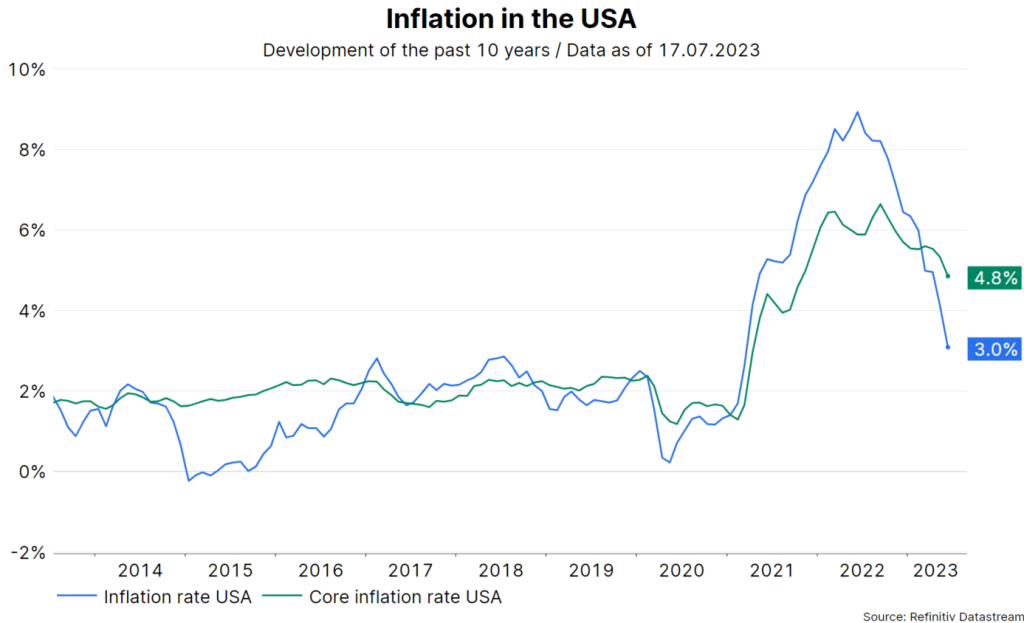Can price stability, i.e. inflation of 2%, be achieved without a recession? The historical relationships between economic indicators answer this question in the negative. But the further decline in US inflation for the month of June has raised expectations for this favorable scenario.
Inflation falls faster than expected
The report on consumer price inflation in the US for the month of June has pointed to a larger-than-expected decline across the board. The overall figure rose 3.0% on an annual basis, down from 4.0% the previous month. The core rate, i.e. excluding the volatile components food and energy, rose 4.8% on an annual basis, which was also significantly below the previous month’s value of 5.3%.

Source: Refinitiv Datastream; Note: Past performance is not a reliable indicator for future performance.
Other indicators also point to a downward trend in price increases. he components with a high persistence of inflation (sticky CPI) increased by 0.2% in the month of June (high: 0.7% in September 2022). The measure preferred by Federal Reserve Chairman Powell, inflation in the services sector excluding food, energy and rents, was actually unchanged month-on-month in June (high: 0.8% in April 2022).
…on a broad basis
In addition, other inflation reports were also favorable. Producer prices showed an increase in the core rate of only 2.4% on an annual basis and US import prices continued to decline to -6.1% year-on-year.
According to the University of Michigan’s flash estimate, consumer inflation expectations for the coming twelve months rose slightly in July (to 3.4% from 3.3%), but the trend is clearly pointing downward. Moreover, a figure of 2.9% would already be a level consistent with 2% inflation. Of course, this is only if the historical relationship between inflation expectations and actual inflation continues to hold.
Furthermore, a report on wage growth by the Federal Reserve Bank of Atlanta showed a further decline. The so-called Wage Growth Tracker fell to 5.6% year-over-year in June (high: 6.7% in June 2022). That level is not yet consistent with 2% consumer price inflation. That’s because productivity growth is low. But the trend in wage inflation is clearly pointing down.
Positive real wages
Classically, the development of wages lags behind that of inflation. Wage growth is thus inconsistent with the definition of price stability, but falling inflation usually means falling wage inflation with a time lag. In the meantime, rising inflation-adjusted wages support personal income and thus private consumption. Indeed, real average hourly wages rose 1.2% year over year in June. This measure had been negative since the second quarter of 2021.
Recession probability down
The falling inflation trend reduces the probability of recession because there is less pressure on the central bank to step up its restrictive policy even further. However, the favorable inflation trend can quickly be cancelled out by future poor inflation reports. Moreover, it is unclear at which level inflation will settle and whether inflation uncertainty or inflation volatility will then remain high or fall.
A key interest rate hike of 0.25 percentage point at the Fed’s upcoming rate meeting remains very likely. It is also likely that the maintenance of a restrictive policy will be reaffirmed, meaning that indications of key interest rate cuts are not to be expected. However, it is also likely that the central bank will signal a longer pause in the rate hike cycle in order to better assess the effects of previous key rate hikes.
Conclusion: Favorable environment for financial markets
The inflation reports in the USA are clearly favorable for the financial markets. First, the main enemy of bonds, high inflation, looks less threatening. Second, the same is true for the main enemy of equities, a recession.
However, history urges caution. In the past, a central bank-induced decline in inflation has often been accompanied by a recession. Therefore, caution is still warranted. A flawless inflation decline (without a recession) would be too good to be true.
For a glossary of technical terms, please visit this link: Fund Glossary | Erste Asset Management
Legal note:
Prognoses are no reliable indicator for future performance.
Legal disclaimer
This document is an advertisement. Unless indicated otherwise, source: Erste Asset Management GmbH. The language of communication of the sales offices is German and the languages of communication of the Management Company also include English.
The prospectus for UCITS funds (including any amendments) is prepared and published in accordance with the provisions of the InvFG 2011 as amended. Information for Investors pursuant to § 21 AIFMG is prepared for the alternative investment funds (AIF) administered by Erste Asset Management GmbH pursuant to the provisions of the AIFMG in conjunction with the InvFG 2011.
The currently valid versions of the prospectus, the Information for Investors pursuant to § 21 AIFMG, and the key information document can be found on the website www.erste-am.com under “Mandatory publications” and can be obtained free of charge by interested investors at the offices of the Management Company and at the offices of the depositary bank. The exact date of the most recent publication of the prospectus, the languages in which the fund prospectus or the Information for Investors pursuant to Art 21 AIFMG and the key information document are available, and any other locations where the documents can be obtained are indicated on the website www.erste-am.com. A summary of the investor rights is available in German and English on the website www.erste-am.com/investor-rights and can also be obtained from the Management Company.
The Management Company can decide to suspend the provisions it has taken for the sale of unit certificates in other countries in accordance with the regulatory requirements.
Note: You are about to purchase a product that may be difficult to understand. We recommend that you read the indicated fund documents before making an investment decision. In addition to the locations listed above, you can obtain these documents free of charge at the offices of the referring Sparkassen bank and the offices of Erste Bank der oesterreichischen Sparkassen AG. You can also access these documents electronically at www.erste-am.com.
Our analyses and conclusions are general in nature and do not take into account the individual characteristics of our investors in terms of earnings, taxation, experience and knowledge, investment objective, financial position, capacity for loss, and risk tolerance. Past performance is not a reliable indicator of the future performance of a fund.
Please note: Investments in securities entail risks in addition to the opportunities presented here. The value of units and their earnings can rise and fall. Changes in exchange rates can also have a positive or negative effect on the value of an investment. For this reason, you may receive less than your originally invested amount when you redeem your units. Persons who are interested in purchasing units in investment funds are advised to read the current fund prospectus(es) and the Information for Investors pursuant to § 21 AIFMG, especially the risk notices they contain, before making an investment decision. If the fund currency is different than the investor’s home currency, changes in the relevant exchange rate can positively or negatively influence the value of the investment and the amount of the costs associated with the fund in the home currency.
We are not permitted to directly or indirectly offer, sell, transfer, or deliver this financial product to natural or legal persons whose place of residence or domicile is located in a country where this is legally prohibited. In this case, we may not provide any product information, either.
Please consult the corresponding information in the fund prospectus and the Information for Investors pursuant to § 21 AIFMG for restrictions on the sale of the fund to American or Russian citizens.
It is expressly noted that this communication does not provide any investment recommendations, but only expresses our current market assessment. Thus, this communication is not a substitute for investment advice.
This document does not represent a sales activity of the Management Company and therefore may not be construed as an offer for the purchase or sale of financial or investment instruments.
Erste Asset Management GmbH is affiliated with the Erste Bank and austrian Sparkassen banks.
Please also read the “Information about us and our securities services” published by your bank.

